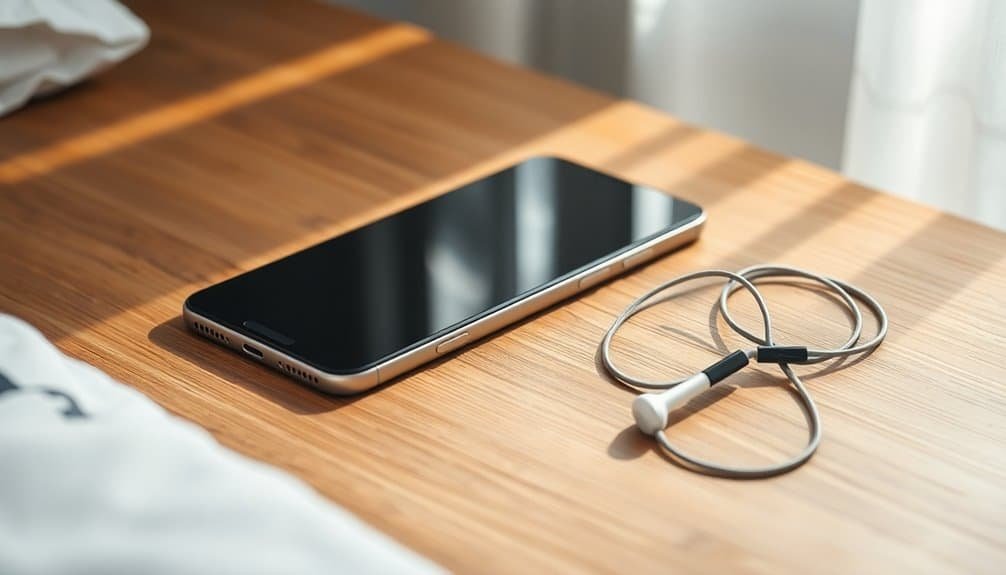Protecting Your Brain From Cell Phone Radiation
To minimize brain exposure to cell phone radiation, use speakerphone or wired headsets to keep your phone away from your head and limit call durations. Texting instead of calling also reduces RF-EMF exposure.
Children’s developing brains absorb more radiation, so exercise caution with their phone use. Implementing these strategies effectively lowers exposure risks and promotes better brain health.
Disclaimer: As an affiliate, I may collect a share of sales from the links on this page.
Understanding Cell Phone Radiation and Its Effects

As you use your cell phone, it’s essential to recognize that it emits radiofrequency (RF) waves, which are a type of non-ionizing radiation found in the electromagnetic spectrum. These waves facilitate communication between your device and cell towers. When your signal strength weakens, such as with only one or two bars, your phone increases radiation levels to maintain connectivity. Unlike ionizing radiation, RF waves can’t break DNA bonds, mitigating cancer risk. Typical exposure levels are low and unlikely to cause significant biochemical effects or tissue heating. Cell phones emit radiation in the radiofrequency range of 0.7–2.7 GHz for older technologies, which emphasizes the importance of understanding their health implications. International standards recommend practices, like using speaker mode, to minimize any potential exposure.
Scientific Perspectives on Brain Cancer Risk
Research into the relationship between cell phone use and brain cancer has generated a range of findings, reflecting the complexities of epidemiological studies.
Current evidence shows no consistent link between cell phone use and brain cancer. While some studies suggest potential risks associated with gliomas and acoustic neuromas after long-term exposure, the overall incidence of brain cancer hasn’t increased alongside rising phone usage. The World Health Organization found no causal connection, emphasizing the non-ionizing nature of cell phone radiation. Furthermore, the analysis reviewed 63 studies, confirming no elevated cancer risks from cell phone exposure. Additionally, many experts agree that EMF exposure within reasonable limits is not hazardous.
Methodological challenges, such as reliance on self-reported data and classification discrepancies, complicate definitive conclusions in this ongoing research area.
Neurological and Behavioral Concerns

Neurological and behavioral concerns linked to cell phone use are gaining attention due to the potential effects of radio frequency electromagnetic fields (RF-EMFs) on young users.
Research shows various issues including:
- Increased risk of headaches and fatigue after heavy use.
- Concentration difficulties in students frequently using mobile devices.
- Sleep disturbances connected to nighttime cell phone usage.
- Behavioral changes such as irritability and mood swings.
Prolonged RF-EMF exposure may disrupt brain energy metabolism, leading to cognitive impairments. Recent studies indicate that long-term cellphone use may also contribute to an increased risk of brain cancer, further underscoring the need for caution. Additionally, studies have observed damage to brain cells from exposure to cell phone frequencies, raising further concerns about long-term health effects.
Although direct evidence of permanent effects in humans remains inconclusive, these findings highlight notable risks associated with ongoing cell phone interactions.
Vulnerable Populations: The Risks for Children
Given their developmental stage, children face unique risks from cell phone radiation that adults do not.
Children’s brains absorb 2-3 times more radiation due to their smaller head size and developing brain structure. This increased absorption results from higher water and ion content in their bodies, enhancing RF energy uptake.
Additionally, long-term exposure poses potential unknown effects on their brain development, as their nervous systems are still maturing.
While studies connect prenatal RF exposure to behavioral changes, there’s inconclusive evidence linking cell phone use to cancer in children.
Regulatory bodies recommend cautious cell phone use among this vulnerable population.
Practical Steps to Minimize Exposure

To minimize exposure to cell phone radiation effectively, you can adopt several practical strategies that adjust your daily habits.
Consider these four steps:
- Use Speakerphone: This keeps the phone farther from your head, lowering radiation absorption.
- Text Instead of Call: Messaging reduces RF-EMF exposure considerably compared to voice chats.
- Limit Call Duration: Shortening calls decreases your overall exposure to radiation.
- Use Headsets: Wired headsets help maintain distance, further reducing RF-EMF effects on your body.
Implementing these actions can help protect your brain health while using your phone, so stay informed and cautious.
Frequently Asked Questions
How Do Different Cell Phone Models Emit Radiation?
Different cell phone models emit radiation differently based on their technology and design. Newer models typically use more efficient networks, resulting in lower emissions, while environmental factors and usage patterns also affect how much radiation you experience.
Is There a Safe Distance to Keep a Cell Phone From the Body?
Is there a safe distance to keep your cell phone? Aim for at least 10 inches from your body to drastically reduce exposure. Consider using speaker mode or a headset for extra protection during calls.
Do Cases and Accessories Reduce Radiation Exposure?
Yes, cases and accessories can reduce radiation exposure, but results vary. Their effectiveness depends on design, proper use, and materials. You should guarantee you’re using them correctly to achieve the best protection possible.
Are Specific Phone Habits Riskier Than Others?
Yes, some phone habits are riskier than others. Holding your phone close to your head for long periods increases exposure, while using hands-free accessories or speaker mode helps minimize potential risks. Stay mindful of your usage.
What Role Do Mobile Network Signals Play in Radiation Levels?
Imagine your phone’s heartbeat racing when signal bars falter. Mobile network signals dictate radiation levels; weaker signals make your device work harder, increasing exposure. Choose strong signals, and let your phone breathe easier—your health might thank you.
Conclusion
In our quest to stay connected, we often overlook the potential risks of cell phone radiation. While scrolling through social media might seem harmless, your brain deserves a break.
Reducing exposure is about more than just good habits; it’s about protecting your future. By taking practical steps to minimize radiation, you safeguard your brain and ensure that your next TikTok dance doesn’t come with health risks.
Think twice, stay wise.


